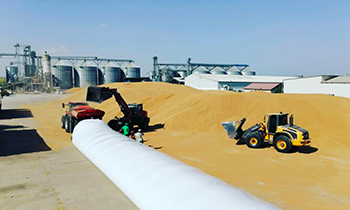10 common mistakes when storing in silobags
Storing efficiently in silobags means following some rules during storage. Breaking these rules brings with it a series of problems that can endanger the grain or feed inside the giant bags. Let’s see which are the most common mistakes:
1. The land is non-compliant
Most often a non-conforming land for placing a silobag is the one with bumps. This can cause both the unevenness of the bag when loaded and the risk of cracking if careless. Furthermore, bumpy areas are collection points for water, and if the bag has cracks in the lower areas, moisture can migrate into the grain.
If a farmer has no other type of land available for storage than a bumpy land, then we recommend excavations for land stripping (if bumps take up a large part of the land area).
2. Not cleaning the land
Stones, branches, roots, metal objects, glass etc. can be found on most soils. All these, if not removed from the field, the silobag foil ca be perforated and the harvest compromised by moisture.
3. The end closure was not hermetically sealed
It is essential to pay attention when closing both ends of the giant bags. The closure must be hermetic and is done with locks, accessories that are available in our offer. In this way, the grains and feed will keep all their properties throughout the storage period, because an anaerobic space has been created inside the bag.
4. Not using sand to cover the bag ends
Why is so important to cover the ends, after they have already been sealed? Because the pressure and low weight at the ends can be a “doorway” for rodents to enter the bag. But if we add a heavy layer of sand where the silobag ends (not necessary at the beginning of the bag because this part is pushed inside and by doing that pressure is created), will not allow rodents in the giant bag. Our advice is to use sand, not soil. Also, to keep mice away, we encourage farmers to clean/sweep the leftovers after loading into the silobag.
5. The bags must not be submerged in water
If there is a large volume of water (after precipitation or melting snow) and there is an unnoticed crack in the foil, water can penetrate inside and the grains soak in water. To avoid that, we recommend farmers to make ditches for water drainage.
6. Lack of safety nets
Birds, especially crows, are another enemy of silobags that can puncture the bag foil. In order not to end up in such unpleasant moments, we suggest farmers to purchase their protective nets from us. They are placed along the entire length of the silobag. The net can be reused for several years.
7. Optimized bagging when loading a silobag
When loading grain or feed into bags it is essential to use a special ruler to measure the amount put into the bags. With this accessory, farmer will know when the bags have reached the limit and will be able to stop the loading process.
8. Not following the recommendations regarding the humidity level when storing
The grain or feed humidity at the time of storage, as well as the storage period, are two key elements for maintaining product quality throughout the storage process. You can find all the information you need about the ideal humidifies for each crop, as well as the storage time and the risk degree for each one, in an easy-to-read chart on our website, in our brochures, but also on our social media channels.
9. Less than 50 cm between bags
50 cm is the minimum distance that must be left between silobags, for the machine to be able to unload and so that the farmers can move between bags, perform their inspection for the surveying process.
10. Not checking the bags regularly
After the bags have been loaded, they must not be “abandoned” during the storage period. It’s good to check them every few days. In this way, certain irregularities can be noticed, such as holes, which can be immediately covered with a special adhesive tape that you can find in our portfolio. When you notice any problem with the bags, we advise you to call us because we can help you with the right solution.
“Attention to detail is a key element in silobag storage. This way, the farmers’ harvest will not suffer any changes during the entire storage period. Our colleagues advise all farmers to strictly comply with the storage rules, which are otherwise very easy to follow”, explains Narcis Ranghiuc, Grain Bags general manager.


